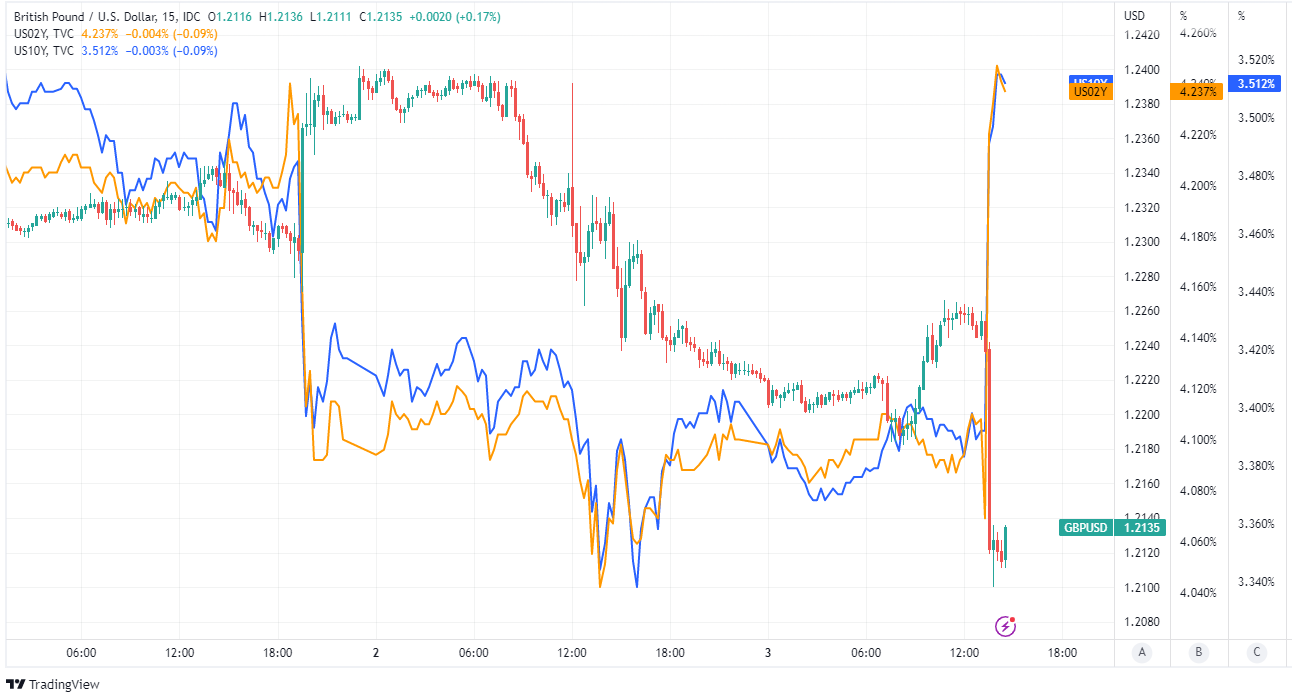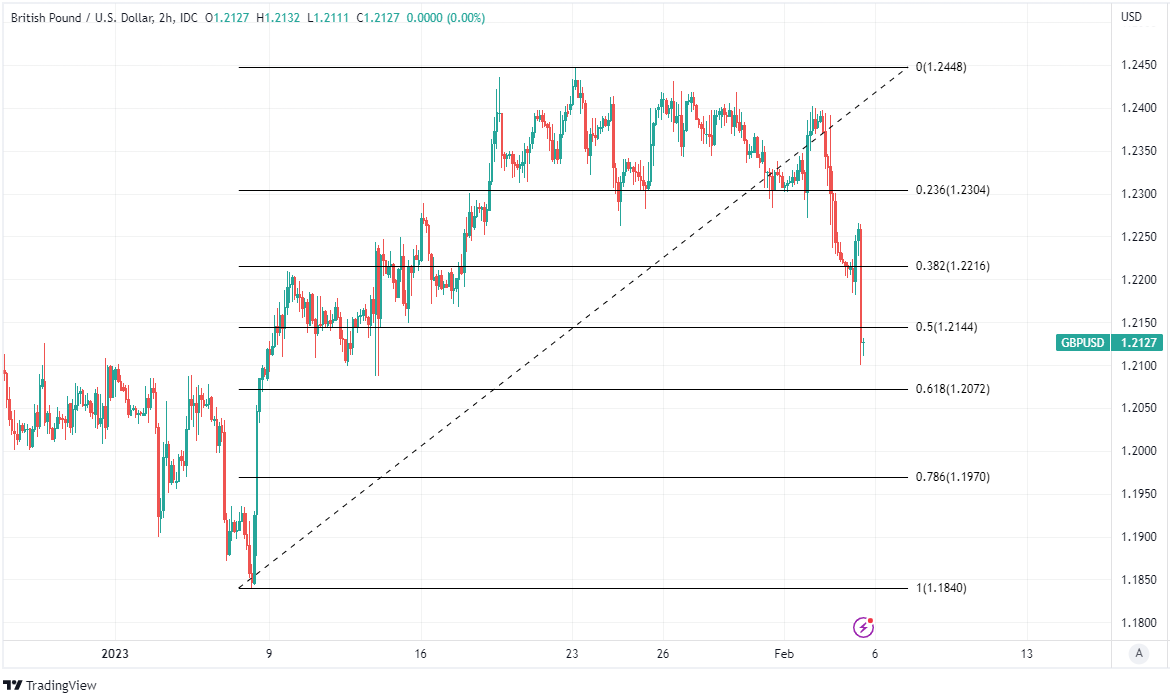Dollar Roars Back on Bumper Jobs Report

Image © Adobe Images
A surge in U.S. non-farm payrolls sent currencies like Sterling and the Euro tumbling against the Dollar while forcing investors to look again at assumptions about the outlook for Federal Reserve (Fed) interest rates.
GBP/USD's Friday loss grew to more than one percent when the Bureau of Labor Statistics said non-farm payrolls rose 517k for January, far more than the 193k anticipated by consensus, leading the Dollar to rally with U.S. bond yields.
Up to 74k of the increase resulted from "the return of workers from a strike" in the government sector but even so the January outcome was still strong enough to undermine recent suggestions the Federal Reserve (Fed) could be likely to end its interest rate cycle in March.
"Data on Friday punctured any thoughts that the US is close to a recession. A whopping half million new jobs were reportedly created in January, the unemployment rate fell to a 53-year low, and the Labor Force Participation Rate rose for the first time since March of last year," says John Velis, FX and Macro Strategist at BNY Mellon.
The unemployment rate unexpectedly fell to 3.4% from 3.5%, defying expectations for unemployment to rise to 3.6%.
Wages grew 4.4% year-on-year as a deceleration extended, however, Velis points out this kind of wage growth "is still far above the 3-ish% that is reckoned to be commensurate with a 2% inflation goal".
"We are quickly going to start to wonder whether the Fed took its foot off the brake too early," says Brent Donnelly, CEO at Spectra Markets and a veteran trader with time at hedge funds and banks like Lehman Brothers and HSBC.
"If you think stocks go down next week, which I do as it seems like we reached peak euphoria/short covering/FOMO yesterday, long USDCAD makes a lot of sense here," he adds while tipping USD/CAD as a buy around 1.3390/95.
Above: Pound to Dollar rate shown at 15-minute intervals with U.S. government bond yields.
Live GBP/EUR Money Transfer Exchange Rate Checker | ||
Live Market Rate: | get quick quote | |
Corpay: | ||
Banks: Median Low | ||
Banks: Median High | ||
These data are based on the spread surveyed in a recent survey conducted for Pound Sterling Live by The Money Cloud. | ||
Friday's non-farm payrolls number was the strongest since that covering the month of July 2022 and came alongside upward revisions to earlier estimates, all of which have taken the market by surprise.
However, some economists including those at Pantheon Macroeconomics had previously cited data collected by private sector payroll company Homebase for thinking there were upside risks to Friday's consensus.
"We think policymakers should put more weight on the improving wage data - which suggest that they are worrying too much about the low unemployment rate - and the clear downshift in core inflation," says Ian Shepherdson, chief economist at Pantheon Macroeconomics.
"But Chair Powell repeatedly emphasized this week that the Fed thinks the labor market is too tight, and the latest payroll and unemployment data do not change that picture. Accordingly, we now think the Fed is more likely than not to hike in March, though we hope they don’t," he adds.
Above: Pound to Dollar rate shown at 2-hour intervals with Fibonacci retracements of 2023 rally indicating possible areas of technical support for Sterling. Click image for closer inspection. If you are looking to protect or boost your international payment budget you could consider securing today's rate for use in the future, or set an order for your ideal rate when it is achieved, more information can be found here.
Friday's data comes after a Wednesday increase in the Federal Reserve interest rate from 4.5% to 4.7%, which was the smallest increase since March last year and was followed by an acknowledgement from Chairman Powell that there might be as little as "a couple" more increases of that size left to go.
A couple more increases would leave U.S. interest rates at roughly the level suggested as their likely peak when Federal Open Market Committee members last updated forecasts in December, though Chairman Powell was also clear on Wednesday that interest rate risk remains on the upside, not downside.
"I think we're going to be looking carefully at the incoming data between now and the March meeting and then the May meeting. I don't feel a lot of certainty about where that [peak] will be," Chairman Powell told the Financial Times.
"I do think that in this situation where we have still the highest inflation in 40 years, the job is not fully done. As I mentioned - started to mention earlier, we have a sector that represents 56% of the core inflation index, where we don't see disinflation yet," he added.
Economists at BNY Mellon retain a view that the Fed will raise rates one more time to 5% (possibly twice more to 5.25%) and hold there for most of the year.
They say this is at odds with market pricing where the market still sees almost 50bp of cuts at the back end of this year.
"We think that the next bout of Fedspeak, which will ramp up this week now that the February FOMC is behind, will push back against this pricing," says Vellis. "The Fed has a significant job ahead to turn market pricing around; it's probably relying on the data to help make its case. Data last week were a good start in that journey, but we think it could be into Q2 before the market finally comes around."
Friday's data also follows a Thursday interest rate decision from the Bank of England in which the BoE dropped its commitment to "act forcefully" if it appears likely at any stage that inflation will remain higher for longer than anticipated.
Live GBP/EUR Money Transfer Exchange Rate Checker | ||
Live Market Rate: | get quick quote | |
Corpay: | ||
Banks: Median Low | ||
Banks: Median High | ||
These data are based on the spread surveyed in a recent survey conducted for Pound Sterling Live by The Money Cloud. | ||

